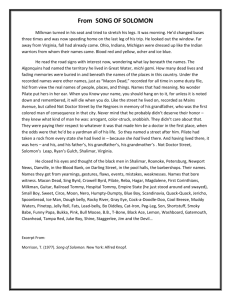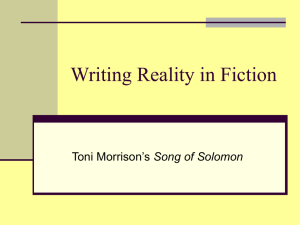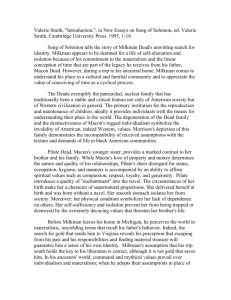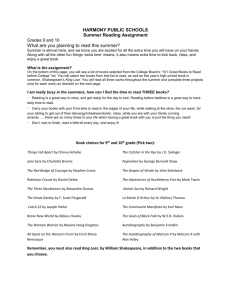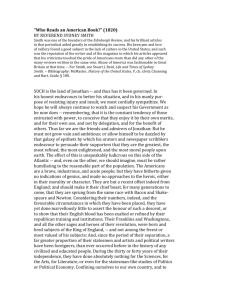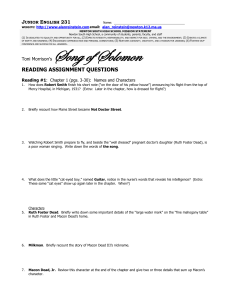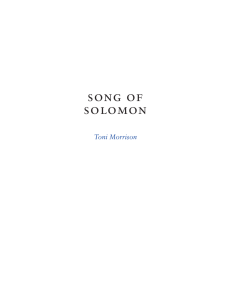"Every Goodbye Ain`t Gone": The Semiotics of Death, Mourning, and
advertisement
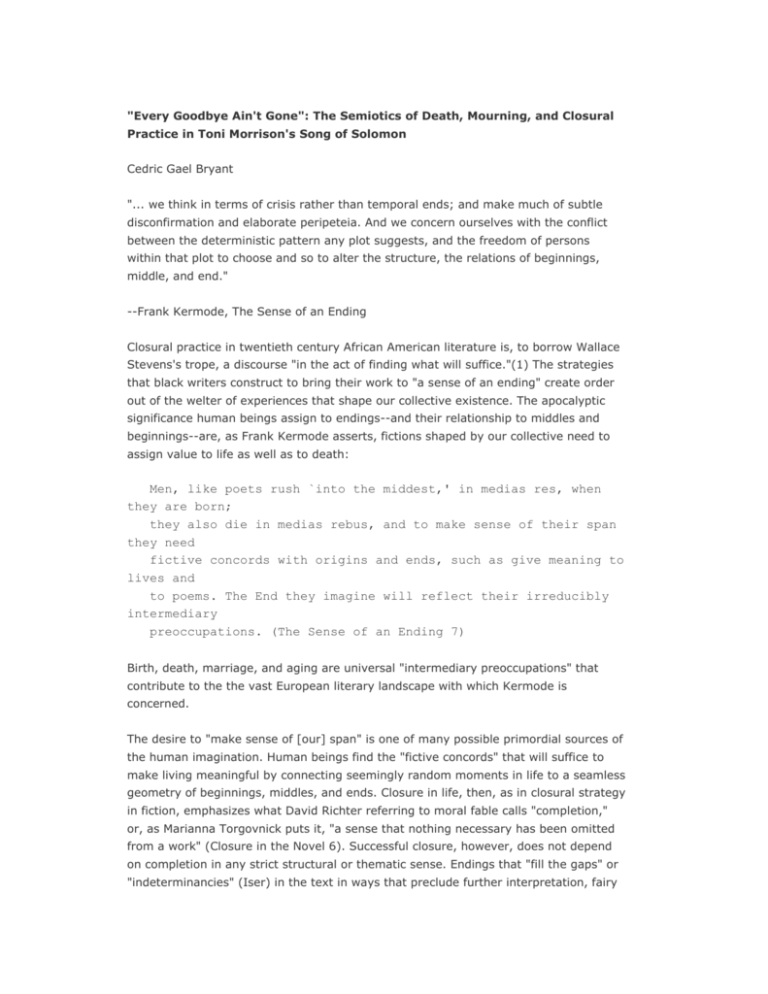
"Every Goodbye Ain't Gone": The Semiotics of Death, Mourning, and Closural Practice in Toni Morrison's Song of Solomon Cedric Gael Bryant "... we think in terms of crisis rather than temporal ends; and make much of subtle disconfirmation and elaborate peripeteia. And we concern ourselves with the conflict between the deterministic pattern any plot suggests, and the freedom of persons within that plot to choose and so to alter the structure, the relations of beginnings, middle, and end." --Frank Kermode, The Sense of an Ending Closural practice in twentieth century African American literature is, to borrow Wallace Stevens's trope, a discourse "in the act of finding what will suffice."(1) The strategies that black writers construct to bring their work to "a sense of an ending" create order out of the welter of experiences that shape our collective existence. The apocalyptic significance human beings assign to endings--and their relationship to middles and beginnings--are, as Frank Kermode asserts, fictions shaped by our collective need to assign value to life as well as to death: Men, like poets rush `into the middest,' in medias res, when they are born; they also die in medias rebus, and to make sense of their span they need fictive concords with origins and ends, such as give meaning to lives and to poems. The End they imagine will reflect their irreducibly intermediary preoccupations. (The Sense of an Ending 7) Birth, death, marriage, and aging are universal "intermediary preoccupations" that contribute to the the vast European literary landscape with which Kermode is concerned. The desire to "make sense of [our] span" is one of many possible primordial sources of the human imagination. Human beings find the "fictive concords" that will suffice to make living meaningful by connecting seemingly random moments in life to a seamless geometry of beginnings, middles, and ends. Closure in life, then, as in closural strategy in fiction, emphasizes what David Richter referring to moral fable calls "completion," or, as Marianna Torgovnick puts it, "a sense that nothing necessary has been omitted from a work" (Closure in the Novel 6). Successful closure, however, does not depend on completion in any strict structural or thematic sense. Endings that "fill the gaps" or "indeterminancies" (Iser) in the text in ways that preclude further interpretation, fairy tales for example, or that restrict the reader's participation in making meaning by such devices as authorial intrusions occur infrequently in twentieth century narrative practice. In Torgovnick's view, structural symmetry is a far less revealing litmus test for successful closure than "the honesty and appropriateness of the ending's relationship to beginning, middle, not the degree of finality or resolution achieved by the ending" (Closure in the Novel 6). This important point is virtually an article of faith in modern and postmodern closural practice in the African American novel.(2) Most twentieth century African American novels in general, and Toni Morrison's Song of Solomon (1977) specifically, resist the "finality or resolution achieved by the ending" expressed as organic wholeness, i.e., structural unity, or themes that mirror the prevailing social mores, or cultural constructions of intermediary preoccupations such as death and mourning. Song of Solomon accomplishes this by its dependence on narrative fragments that ultimately form interconnected circles within circles that resist simple finality or closure by stressing the familial, experiential, and human ties that bind in constantly changing ways. The broad cultural resonance of this teleology is implicit, for example, in the traditional African American aphorism, "every goodbye ain't gone, every shut eye ain't sleep." As a trope of resistance, "every goodbye ain't gone" is a textual site for any number of possible political, physical, and metaphysical struggles that form an historical map of the universal particularity of African American experience, including slavery, migration, racism, religion, and family. Resistance is a trope that triumphantly insists on myriad ways of expressing "goodbye" and being "gone," that transcend mere physical presence or absence; that insinuates ways of seeing and watchfulness that belie "sleep," i.e., death. It also suggests magical realism's possibilities for "being" in ways that subvert pragmatic, objectivisitic constructions of reality. It is a trope that charts a terrain of consciousness without borders, and avows, as Emily Dickinson does, that This World is not Conclusion. A Species stands beyond-Invisible, as Music-But positive, as Sound-It beckons, and it baffles--.... (501) Song of Solomon epitomizes subversive closural practices in the African American narrative tradition that, as Dickinson's poem implies, denies death's dominion by rejecting the prevailing cultural constructions of it. Toni Morrison's novels typify the African American narrative practice that works within and against Judeo-Christian apocalytic teleology and conventional closural practice. "The language," Toni Morrison has said, must appear to be effortless, "seamless" (Bakerman 56). Throughout Morrison's fiction, the circle is a seamless geometric figure and unifying principle of closure. In Sula (1973), for example, circularity informs Morrison's method of interconnecting narrative elements by reversing causality, that is, writing or conceptualizing backwards from effects to causes. Referring to the composition of Sula, her second novel, Morrison described this process as hiding certain scenes that are clear to me, that I have a feeling, the language, the metaphor, for. I do those, and they may appear at any point in the book, I've never written the beginning of any book first; I didn't know the beginning, I just start! As a matter of fact, on Sula, I knew myself from the beginning that the last words would be, "`Oh ... girl, girl, girl-girlgirl .... `So I wrote it, but then I wrote some more, and I wrote some more! (Bakerman 57) Morrison's proposition inverts Edward Said's insistence that the beginning "is the first step in the intentional production of meaning" because it is "the first point (in time, space, or action) of an accomplishment or process that has duration and meaning" (Beginnings 5). Said's construction presumes an orderly linearity--an absolutism that fixes meaning in time and space--whereas Morrison's narrative practice locates meaning in disorder and repetition. This way of writing involves the reader in "retrospective analysis" that fills the "gaps" or "indeterminancies" in the text caused by reversing causality. Gaps in the text get filled, ill part, because the reader is compelled to circle back to and re-conceptualize narrative elements that have been suspended or separated from their causes (Iser 54-58). This separation of effects from their causes, for example, occurs repeatedly in the beginning of Song of Solomon, as it does in Robert Smith's cryptic message and enigmatic suicide leap from atop Mercy Hospital (1-3); the image Macon Dead retains of his wife, Ruth, with "her mouth on the dead man's fingers" (16); and, the oblique references to anger and betrayal "all those years after [Macon Dead and his sister, Pilate] had separated outside that cave" (20). In each instance, the causes that explain these peculiar events and that make fragmented narratives whole occur throughout the text. "Parallelism" is Torgovnick's term to describe places where "the language, situation, or the grouping of characters refers not just to the beginning ... but to a series of points in the text" (13). In Song of Solomon, parallelism occurs when causes and effects that have been suspended or fragmented are brought together at various junctures throughout the text to form meaning. For example, the narrator's reference to Ruth's relationship to her dead father conjures ambiguous images of incest and necrophilia that become clearer, although no less perverse, later in the text when her husband, Macon Dead, recounts the event to their son, Milkman. "In the bed," Macon explains, "That's where she was when I opened the door. Laying next to him. Naked as a yard dog, kissing him. Him dead and white and puffy and skinny, and she had his fingers in her mouth" (emphasis added 73). Macon Dead's narrative reconstruction is both a confirmation and a revision of the first reference to this event (16) that alters the "facts" by placing the "naked" daughter "in bed" with her father, sucking his bloated fingers. Macon's narrative retelling and revisioning transforms incest and necrophilia from innuendo and conjecture into putative facts. When Doctor Foster's death is reconstructed from Ruth's own memory later in the text, the ways in which the novel's closural form is bound up with its epistemological content becomes apparent. Ruth's retelling disrupts Milkman's sense of what he knows about his parent's relationship and pushes him closer to the point that the narrator calls a "beginning" (126)--that is, a movement away from solipsism to a familial-centered world view. The readers' responses must be revised as well because we are forced into the kind of retrospective analysis that acknowledges the subjective and constitutive nature of "truth": we are compelled to acknowledge the relative truth inherent in each narrative reconstruction. Milkman Dead, the novel's protagonist, can not soar to a higher plain of understanding without comprehending the complexity of a world in which reality is mutable and truth is transcendent. These epistemological issues are implied in the difference between Macon Dead's view of Ruth as perverse and "strange" and Ruth's sense of herself as simply "small": I don't mean little; I mean small, and I'm small because I was pressed small. I lived in a great big house that pressed me into a small package. I had no friends, only schoolmates who wanted to touch my dresses and my white stockings. But I didn't think I'd ever need a friend because I had him [her father]. I was small, but he was big. The only person who ever really cared whether I lived or died. (124) Ruth's response to her son's question, "`Were you in the bed with your father when he was dead? Naked?'" is a disconfirmation of a "truth" that, until this moment, the text seemed to affirm: "`No. But I did kneel there in my slip at his bedside and kiss his beautiful fingers. They were the only part of him that wasn't ..." (126). Ruth says that "`I am not a strange woman. I am a small one" (124). "Smallness" and "strangeness" can mean the same or different things, depending upon what point of view is being privileged. In effect, the persuasive ways the text moves in and out of different perceptual categories argues against bifurcated constructions of reality and for understanding the diverse ways reality is formed from human experience. Thematically, dispossession, inheritance, and memory are crucial elements of cultural identity and wholeness with which each of these characters, but especially Milkman Dead, must come to terms. The measure of the importance of these issues is implicit in the characters' profound estrangement from the world around them--family, history, language--and is especially indicative of the men in this novel. This complex relationship to the world is inscribed, for example, in the "keys" that Macon Dead carries in his pocket: Macon Dead dug in his pocket for his keys, and curled his fingers around them, letting their bunchy solidity calm him. They were the keys to all the doors of his houses (only four true houses; the rest were really shacks), and he fondled them from time to time as he walked down Not Doctor Street to his office. (emphasis added 17) As this passage suggests, Macon is obsessive and authoritarian, a collector driven by what seems an utterly ruthless need to possess property and people--to "display" and "parade" his children (216) and wife like a valuable hood ornament on his vintage Hudson automobile. Macon's ruthlessness, Ruth's "smallness," Milkman's search for wholeness, and Pilate's song are all responses to loss that are developed by key events that occur later in the text: Macon's narrative about the vicious way his father is robbed of his land--a stolen inheritance that Macon tries to reclaim by perverting it into a self-consuming need to dominate (51-52); Milkman eventually identifies with his paternity by saying "`I work right alongside him in our office'" (237), an assertion that repeats his father's words and signals the gradual reclamation of his familial identity; the green tarp that hangs from the ceiling in Pilate's house, which she calls her "inheritance" because she mistakenly believes that it contains the body of a white man she may have killed; and the play on "inheritance" that transforms Milkman's literal quest for gold into an historical search, through memory and language, for cultural identity. The themes of loss, reclamation, and moral responsibility are implied in Pilate's knowing that her "inheritance" lies in the responsibility to her dead father's body; and they are also embodied in the white man's bones she mistakenly carries with her. Her father's ghostly refrain, "you just can't go off and leave a body," has multiple implications, including the acknowledgement of universal "kinship" ties to the human family. The triadic relationship among author, reader, and text is dynamic, phenomenologically complex because the reader's perceptions are always changing as the text moves us in and out of different perceptual categories, including various narrative points of view and constructions of time. In early eschatological doctrines, for example, "disconfirmation" was the inevitable final stage of so-called "Doomsday" millennialism and led to new, corrective predictions and expectations based on the analysis of data-- misinterpreted sacred and profane "signs" (like solar eclipses, floods, and droughts) and mathematical miscalculations--that could be retrospectively corrected. The "end," then, of a reign or of the world could be altered to fit the reality shaped by adjusting one's perceptions of the observable, phenomenal world. Throughout Song of Solomon, the reader's responses to the novel's closural design are shaped by what Wolfgang Iser calls the "phenomenological reading process" in which the reader (subject) interacts with the text (external, objective world) in reciprocal ways. The contemporary reader, like medieval eschatologists, uses retrospection to modify his or her perceptions, in medias res, to accomodate the changing phenomenolgical world of the text. The changes that ultimately determine the reader's sense of an ending, however, as Torgovnick's closural ideas suggest, are themselves contentious because the reader must be "coaxed" or persuaded to accept an ending that may be "incongruent" with the one anticipated or desired.(3) The end of Song of Solomon appears to be incongruent because it is compounded by "gaps" or "indeterminancies" created by our uncertainty about whether Milkman dies and what meaning can be assigned to his life or the manner of his departure from it. The final passage in Song of Solomon circles back to the very first page where Robert Smith, an insurance agent with North Carolina Mutual Life Insurance, has left a suicide note two days before promising "to fly from Mercy to the other side of Lake Superior" (3). His note reads: "At 3:00 P.M. on Wednesday the 18th of February, 1931, I will take off from Mercy and fly away on my own wings. Please forgive me. I loved you all" (3). Over three hundred pages later, the dramatic scene that brings the novel to a close also implies suicide: `Guitar! ... You want me? ... You want my life? You need it? Here.' Without wiping away the tears, taking a deep breath, or even bending his knees-he leaped. As fleet and bright as a lodestar he wheeled toward (guitar and it did not matter which one of them would give up his ghost in the killing arms of his brother. For now he knew what Shalimar knew: If you surrendered to the air, you could ride it. (337) These two expressions of flight, at the beginning and the end are, in a sense, bookends that buttress the material in the middle of the novel. They are also reciprocally clarifying commentaries because without Milkman Dead's self-sacrificial gesture at the end, Robert Smith's at the beginning would be the only context for the idea of flying, one the novel's central myths. Retrospective analysis reveals that the ending "clearly recalls the beginning in language, in situation, [and] in grouping of characters" (Torgovnick 13), but is also the basis for assigning different meanings to the end and the beginning based on their significations. The beginning and end of Song of Solomon, Robert Smith's act and Milkman's, signify on each other by repeating and revising the myth of flight in ways that establish a dialogue about the novel's central thematic issues: the inextricability of life and death and the moral imperative to find meaning in them. Robert Smith's death is an explicit sign that is parodic because the gaudy, "wide blue silk wings" (5) sabotage the conventional associations of flying with life, renewal, and fulfillment. As a life insurance salesman, Smith is already "heavily associated with illness and death" (8). His extravagant costume mocks the seriousness of life and death but engenders little more than mild curiosity from the crowd that has formed to watch. Even the plain, business-as-usual tone of his note tacked to his door is ironic, a bad joke played on whoever reads it. Robert Smith's blue winged "flight" from Mercy Hospital is a gesture that parallels both Solomon's legendary flight from the outcropping of rock that bears his name and Milkman's leap from the same place. However, the message signified by each is quite different: Robert Smith's death is a tragic gesture and a paradoxical means of communication, since only an exceptional individual, like Pilate, can successfully decode the meaning of the parodic figure he forms atop Mercy Hospital. Pilate's song about Sugarman is a kind of serenade or eulogy to Robert Smith, a cryptic, fragmentary sign suspended from the various contexts needed for either the people gathered to watch, or the reader to make sense of immediately. Nevertheless, Pilate can decode the meaning of Robert Smith's bizarre behavior because she is able to read the signifying relationship between Smith's "flight" and the legendary Solomon (Sugarman) who used flight to escape slavery. However, since causality is fragmented here, Smith's involvement in the Seven Days, for example, cannot be brought to bear on his suicide in this place in the novel. The Seven Days' philosophy is predicated on cold, calculated revenge--a life for a life without benefit of due process or regard to questions of innocence or guilt: "`And if it ever gets to be too much,'" Guitar confides to Milkman, "`like it was for Robert Smith, we do that rather than crack and tell somebody'" (158).(4) Robert Smith is entangled in a labyrinth of moral contradictions layered in a multicultural tradition of mythic flight that implies the possibility of escape: enslaved Ibos walking across and flying over oceans to freedom; Daedalus and his son Icarus fleeing the labyrinth and the Minotaur; and Sugarman. Pilate's song signifies on this tradition too by implicitly comparing Robert Smith to Sugarman. Her song implies that Smith, like Sugarman (Solomon) who left his only son Jake behind, also leaves at least one person behind who cares about him and who celebrates his going--although Pilate "knows" him no better than anyone else does. What this important moment at the beginning of the text offers is a dialogue between signifying acts--Robert Smith's, Solomon's, and Milkman's--that form text and subtext for one another without ever surrendering their full meaning. Robert Smith's enigmatic suicide remains a "gap" in the text until it achieves partial disclosure through parallelism and circular ties to Milkman's death at the novel's end. Various possible motives explain Robert Smith's suicide, including Porter's drunken suggestion that Smith's suicide was motivated by love that became a burden too heavy to carry: "`I'll take hate any day. But don't give me love. I can't take no more love, Lord. I can't carry it. Just like Mr. Smith. He couldn't carry it. It's too heavy. Jesus, you know'" (26). At one level, this is simple projection, Porter's boozy effort to read his own thwarted love for First Corinthians--a relationship that Macon Dead breaks up--in the blank spaces of Robert Smith's secret life. Nevertheless, Porter's conjecture about a love too heavy to support opens up the text in several possible ways: first, the public knowledge about Robert Smith's life is that there's no love in it (8-9), which may be a consequence of its being "too heavy to carry." But, more interestingly, if Guitar's own motivation for his involvement in the Seven Days is assigned to Robert Smith, then the idea of love being too heavy to support becomes thematically important. Guitar's response to Milkman's insistence that there's "`no love'" in a life that makes you a killer and prevents you from marrying and having children is, "`What I'm doing ain't about hating white people, It's about loving us. About loving you. My whole life is love'" (emphasis added 159). However, for Robert Smith a love that kills may easily become a love too great to bear. Milkman's death is also an expression of love, but not the dangerous expression of self-centeredness that justifies murder and that prevents the peacock from flying: "`Like vanity. Can't nobody fly with all that shit. Wanna fly, you got to give up the shit that weighs you down'" (179). Milkman's ability to transcend the spirit-killing relationships to crass materialism, family, history, and language that make him earthbound is inferable from not only the novel's final, equivocal imagery but also an earlier scene that parallels it. In chapter twelve, Milkman dreams of flying, But not with arms stretched out like airplane wings, nor shot forward like Superman in a horizontal dive, but floating, cruising, in the relaxed position of a man lying on a couch reading a newspaper. Part of his flight was over the dark sea, but it didn't frighten him because he knew he could not fall. He was alone in the sky, but somebody was applauding him, watching him and applauding. (299) His dream does not reveal who is watching and applauding him, but the end of the novel fills this gap in two possible ways. Guitar is clearly one of the watchers and "applauds" because for him Milkman's suicide is an admission of guilt and a debt paid in full with Milkman's life. Guitar's acknowledgment "`my man ... my main man'" codifies Milkman's death in a ritual of manhood: by opting to stand-up and take his own life rather than be shot down like a coward, Milkman appears to admit his guilt and elects to die "like a man." This earth-bound, ego-centered kind of manhood serves as the terminus a quo for Milkman's journey towards a more communal and feminized consciousness. In a second construction, which is at once more poetic and appropriate to the novel's themes and closural design, the second watcher is Milkman's mythical ancestor, Solomon. Doubling between Milkman and Solomon is apparent here in at least two ways: the superimposition of their "leaps" from the same outcropping of rock; and their shared consciousness and mastery of flight--"For now he knew what Shalimar knew: If you surrendered to the air, you could ride it" (337). Milkman's "surrender" is an empowering, renunciatory' act that transfigures death and loss--lost love, names, histories, and language--into enduring myths about renewal and hope. The context for "surrender" and "death" in these final sentences is clearly symbolic, i.e., magical, and has far more in common with Carl Jung's archetypal meaning of "rebirth" than the tragically literal death that begins the novel. "Rebirth," Jung suggests, involves "the idea of renovatio, renewal, or even improvement brought about by magical means" (48). This kind of magical transformation involves "parts of the personality" that are "subjected to healing, strengthening, or improvement" (Jung 48). Rebirth may result in "transmutation," i.e, a change in one's "essential nature," such as the transformation of "a corporeal into a spiritual being" (Jung 48). Both meanings are implied in the final apocalyptic imagery in Song of Solomon, although the idea of transmutation, perhaps, better describes Solomon's mythical flight from bondage than Milkman's quest for wholeness. Milkman's ability in the last page to "surrender" his life into the "killing arms" of his former best friend, Guitar -- "You want my life?' ... You need it?"--is a powerful, altruistic expression, which Milkman would not have been able to make without having first, in William Blake's apocalyptic imagery, "cleansed doors of perception" through the epic-like journey that his aunt, Pilate, helps him to complete. Pilate accomplishes this transformation in ways analogous to Jung's emphasis on healing, strength, and improvement, which, in Song of Solomon, accrue from the reclamation of (cultural/familial) history and language. It is this kind of magical renovatio that inscribes Morrison's work with so much hope and lyrically expresses the revisionary spirit that configures closural practice in the African American narrative tradition. Pilate's life and death signify the care and nurture of the mind and body by giving life to people who come into the orbit of her influence. She is "pilot," or spirit-guide, not only to Milkman Dead in his search for selfhood, but caretaker of her father's body of bones, which she will ultimately take to a final resting place.(5) In this role, Pilate becomes an "embodied Muse"--at once both Beatrice and Virgil--without whom Milkman can not find the path that leads him back (even as his journey takes him forward) to a cultural identity that transcends base self-interests. The embodied Muse performs an "internal drama" and exploration of the self related to the disappearance of God, which compels human beings to turn inward to make meaning of their existence. This modernist effort to find meaning is expressed in the experimentation with novelistic closure that, despite the modernist turn inward to the self and away from God, is shaped by the apocalyptic imagery of Judeo-Christianity.(6) The result is what William R. Thickstun calls "visionary closure," which makes a radical departure from the conventional fictional climax in death or marriage; it enables the work to end on a note of aesthetic finality that leaves future events in the lives of the characters relatively underdetermined. The most influential model for visionary formal structure is the Bible, which parallels temporal structure--past, present, future--in moving structurally from Genesis, through Incarnation, to Revelation .... (13) Like the canonical British novels that both Thickstun's and Kermode's studies of apocalyptic closure emphasize, African American literary practice also signifies on the Judeo-Christian tradition by reshaping apocalyptic symbolism such as the Incarnation and Revelation into motifs of cultural reclamation, i.e., the recovery of language, history, and identity.(7) Song of Solomon achieves this by synthesizing either / or bifurcations of the temporal and spiritual, secular and profane imagery into transformative ways of seeing and constructing the Self. One of the apocalyptic images, for example, that Toni Morrison uses is a version of the embodied Muse that derives from cross-cultural influences--the Biblical iconography of the Holy Mother, classical mythology, Dante's Beatrice, through English Romantic appropriations of the Muse as a secularized and feminized trope for "Nature." For Morrison, the embodied Muse is an inspirational, female character in a fictional work who intercedes as the text ascends toward a "final revelation" and whose death subverts the ideas of finality and the "end" through the reclamation of life by the living. In the role of embodied Muse, Pilate plays Dante's Beatrice and helps shape Milkman's feminization through the inspiriting lessons about the damning effects of patriarchal privilege. Milkman's journey towards enlightenment is also attributable to his sister Lena in chapter 9 (211-16) and to Hagar's death in chapter 13 (313-191). In Song of Solomon, avarice, self-hate, and gender bias fracture the self into male and female principles that must be harmonized to produce both a holistic communal consciousness and an individual identity. Through a journey that retraces and doubles Pilate's own development, Milkman is brought to the place, Solomon's Leap, that completes his "rebirth" into the sum of all his ancestral parts--male and female, past and present, corporeal and spirit, myth and reality. The song Milkman sings as Pilate dies-"`Sugargirl don't leave me here / Cotton balls to choke me / Sugargirl don't leave me here / Buckra's arms to yoke me'" (337)--although a lament of loss and separation, unites Milkman to the living and to the dead: to Robert Smith's, Solomon's, Hagar's, and Pilate's "passing." And the song prefigures Milkman's own "surrender" to the air. Pilate also revises the Muse by being intimately associated with loss and death--she is a "motherless child" whose mother dies giving her life, and tied to Pontius Pilate, "the name of the man that killed Jesus" (19). Both signifiers are appropriate, Pilate the spirit-guide and the "Christ-killing Pilate" (19), for a seemingly magical person who gives herself life by struggling out of her dead mother's womb; whose magic is used to assist the conception of her nephew; and whose hand holds the knife that could take the life of the man who beats her daughter, Reba. Pilate performs a specifically gendered form of the embodied Muse, protecting Reba and granddaughter Hagar from the repressive authority that men exercise over women (93-95). The knife that Pilate pushes under the skin, just over the heart, holds the abusive man's life in the balance: "Now, I'm not going to kill you, honey. Don't you worry none. Just be still a minute, the heart's right here, but I'm not going to stick it in any deeper. Cause if I stick it in any deeper, it'll go straight through your heart. So you have to be real still, you hear? You can't move a inch cause I might lose control." (94) Pilate's ironic voice overlays the vengeance she feels with sugar-coated kindness and her irony thematizes an important point: we each hold lives, present and past, in our hands and must be guardians against abuses of our power over life and death. In a note that prefaces his novel, Sent For You Yesterday (1983), John Edgar Wideman captures Song of Solomon's sense of moral responsibility to the living and the dead: Past lives live in us, through us. Each of us harbors the spirits of people who walked the earth before we did, and those spirits depend on us for continuing existence, just as we depend on their presence to live our lives to the fullest. The influence that Pilate exerts as "pilot," teacher, and embodied Muse through her ability to inspire others to affirm life over death, family over self-interests, love and forgiveness over hate and vengeance is the catalyst--well before the final page--for the novel's life-affirming, transcendent, and celebratory closural shape. The end, proclaims the protagonist of Invisible Man, is in the beginning and the beginning is the end. In Sent For You Yesterday, a character called "Brother" transforms his mourning over his son's death into a defiant recognition of life's--the "it" that never stops--inexorable claim on us: "As long as there's you, I am. It never stops. Nothing stops. We just get tired and can't see no further. Our eyes get cloudy. They close and we can't see no further. But it don't stop" (171). And still another, realizing just how much past lives live in him says, "Just a circle going round and round so you getting closer wile you getting further away and further away while you getting closer" (118). Like Song of Solomon, these novels are passionate expressions of the impulse in African American narrative practice and culture to "make sense of [our] span" and to find what will suffice in a society where black existence is inscribed in so many markers of struggle, subjugation and, ultimately, death. Finally, the powerful myth of flying, of soaring, is Song of Solomon's first and final trope and its resistant, shape-shifting response to the forces that oppress the human spirit and keep it earthbound. This essay is dedicated to the memory of Ray, Ronnie, Errol, Danny, Becky, and Sherley Anne: every goodbye ain't gone. Notes (1.) This quotation is from Wallace Stevens's poem, "Of Modern Poetry," which begins "The poem of the mind in act of finding / What will suffice. It has not always had / To find: the scene was set; it repeated what / Was in the script." (2.) None of the important book-length studies of closure--narrative, verse, or fable-being discussed concerns closure in African American literature or culture. See William R. Thickstun's Visionary Closure in the Modern Novel, Marianna Torgovnick's Closure in the Novel, Barbara Herrnstein Smith's Poetic Closure: A Study of How Poems End, Frank Kermode's The Sense of an Ending: Studies in the Theory of Fiction, and Robert Adams's Strains of Discord: Studies in Literary Openness. (3.) "Complementary" relationships, in which "the reader accepts--more or less uncritically--both the ending itself and whatever meaning (or lack of meaning) the author wishes to convey," occur less frequently in modern and postmodern narratives, according to Torgovnick. (4.) There are seven members of the Seven Days, each assigned a day of the week; Guitar is the "Sunday man." Robert Smith may be the "Wednesday man" for two circumstantial reasons. The note that Smith tacks to his door is dated Wednesday, the day he commits suicide. And, in the sentences immediately preceding Guitar's disclosure that Smith was one of the Days, Wednesday is one of two hypothetical days used to illustrate how the random selection of white people to be killed is made: "If the Negro was killed on a Wednesday, the Wednesday man takes; if he was killed on a Monday, the Monday takes that one. And we just notify one another when it's completed, not how or who" (158). Smith may have taken his own life, at least in part, to pay back a debt owed for the lives he has taken as a member of the Seven Days. If so, Smith's suicide is an ironic reversal of the emphasis this secret society places on "balance" and "ratio." The more obvious way Robert Smith's death is connected to life is by figuratively passing on the obsession with flying to Milkman, the child who is born, as Pilate says, "`right on time,'" (9) the next day in Mercy Hospital. (5.) That Pilate does not know the green tarp contains her father's bones is an irony worth pointing out because it underscores the part that misdirection and ignorance play in shaping "reality" and memory. However, what matters still more is the theme of moral responsibility to past lives, which is applicable no matter what the dead person's identity. (6.) The parallelism between Judeo-Christian eschatology and literary closural theory is the central subject of both William R. Thickstun's book and Kermode's seminal work, The Sense of an Ending; see as well Joyce A. Rowe's Equivocal Endings in Classic American Novels. (7.) Thickstun's important work includes a very interesting chapter on Dilsey and the "apocalyptic" fourth section of William Faulkner's The Sound and the Fury. See also Marianna Torgovnick's discussion of Joe Christmas in Faulkner's Light in August in chapter 8 of Closure in the Novel. However, neither of these important studies of closural practice considers African American narrative practice. Works Cited Awkward, Michael. Inspiriting Influences: Tradition, Revision, and Afro-American Women's Novels. New York: Columbia UP, 1989. Bakerman, Jane. "`The Seams Can't Show': An Interview with Toni Morrison." Black American Literature Forum, 12 (Summer 1978): 56-60. Ellison, Ralph. Invisible Man. 1952. New York: Vintage, 1989. Iser, Wolgang. "The Reading Process: A Phenomenological Approach." ReaderResponse Criticism: From Formalism to Post-Structuralism Ed. Jane P. Tompkins. Baltimore: Johns Hopkins UP, 1980. 50-69. Johnson, Thomas H. (ed). The Complete Poems of Emily Dickinson. Boston: Little Brown, 1960. Jung, Carl. Four Archetypes: Mother, Rebirth, Spirit, Trickster. New Jersey: Princeton UP, 1959. Kermode, Frank. The Sense of an Ending: Studies in the Theory of Fiction. New York: Oxford UP, 1966. Morrison, Toni. Playing in the Dark: Whiteness and the Literary Imagination. Cambridge: Harvard UP, 1992. --. Song of Solomon. 1977. New York: New American Library, 1987. --. Sula. 1973. New York: Plume/Penguin, 1983. Richter, David H. Fable's End: Completeness and Closure in Rhetorical Fiction. New York: U of Chicago P, 1974. Rowe, Joyce. A. Equivocal Endings in Classic American Novels: The Scarlet Letter, Adventures of Huckleberry Finn, The Ambassadors, The Great Gatsby. New York: Cambridge UP, 1988. Said, Edward W. Beginnings: Intention and Method. New York: Columbia UP, 1975 Smith, Barbara Herrnstein. Poetic Closure: A Study of How Poems End. New York: U of Chicago P, 1968. Thickstun, R. William. Visionary Closure in the Modern Novel. New York: St. Martin's, 1988. Torgovnick, Marianna. Closure in the Novel. Princeton: Princeton UP, 1981. Wideman, John Edgar. Sent For You Yesterday. New York: Vintage, 1983. Cedric Gael Bryant is Associate Professor of English and American Literature at Colby College, specializing in African American literature. He is a contributor to The Oxford Companion to African American Literature and has published in various journals, including The Southern Review and Black American Literature Forum (now the African American Review). He is currently working on a book project that explores the African American Gothic tradition. COPYRIGHT 1999 The Society for the Study of the Multi-Ethnics Literature of the United States COPYRIGHT 2004 Gale Group
